Cultural Approach to Sexual Dimorphism
VerifiedAdded on 2023/03/17
|17
|5167
|22
AI Summary
This assignment explores the concept of sexual dimorphism and its relation to socio-cultural approaches. It discusses the various secondary sexual characters and their differences between genders. It also examines how sexual dimorphism is influenced by the environment and its impact on mate preferences. Additionally, it explores the role of sexual dimorphism in biological and forensic anthropology.
Contribute Materials
Your contribution can guide someone’s learning journey. Share your
documents today.

Running head: ANTHROPOLOGY
Cultural approach to sexual dimorphism
Name of the Student
Name of the University
Author Note
Cultural approach to sexual dimorphism
Name of the Student
Name of the University
Author Note
Secure Best Marks with AI Grader
Need help grading? Try our AI Grader for instant feedback on your assignments.

1ANTHROPOLOGY
Introduction
Sexual dimorphism is an umbrella term that encompasses a particular condition
characterized by exhibition of varied characteristics by two sexes of a particular species. In
addition, these difference are generally manifested way beyond the sexual characters and are
found in several plants and animals as well. The major characters that vary during
dimorphism include secondary sexual features, color, size, weight, markings, cognitive, and
behavioral differences (Dixson, 2015). Furthermore, it has also been found that the characters
are often subjected to different types of sexual selection or might get exaggerated. There is
mounting evidence for the fact that sexual dimorphism comprises of the dissimilar
identification of two sexes or each species, and also encompasses their phenotypic
expression, in the form of a multi-stage process at gonadal, hormonal, chromosomal, and
behavioral level (Puts, 2016).
In human beings there are five factors, the presence of which at birth helps in the
determination of the sexuality namely, absence or presence of Y chromosome, sex hormones,
external genitalia, type of gonads, and internal anatomy of reproductive organs. It has often
been established that the aforementioned five factors are either female or male that rarely
does any form of sexual ambiguity exist in human beings. It needs to be mentioned that the
term gender although plays an important role, it has recently gained attention in the domain
of biological anthropology (Rigby & Kulathinal, 2015). Following decades of research and
critical discussion, the patterns of differentiation into social gender and biological sex have
been identified as an important biological phenomenon. This assignment will elaborate in
details on the concept of sexual dimorphism, in relation to socio-cultural approaches, by
utilizing scholarly pieces of literature.
Introduction
Sexual dimorphism is an umbrella term that encompasses a particular condition
characterized by exhibition of varied characteristics by two sexes of a particular species. In
addition, these difference are generally manifested way beyond the sexual characters and are
found in several plants and animals as well. The major characters that vary during
dimorphism include secondary sexual features, color, size, weight, markings, cognitive, and
behavioral differences (Dixson, 2015). Furthermore, it has also been found that the characters
are often subjected to different types of sexual selection or might get exaggerated. There is
mounting evidence for the fact that sexual dimorphism comprises of the dissimilar
identification of two sexes or each species, and also encompasses their phenotypic
expression, in the form of a multi-stage process at gonadal, hormonal, chromosomal, and
behavioral level (Puts, 2016).
In human beings there are five factors, the presence of which at birth helps in the
determination of the sexuality namely, absence or presence of Y chromosome, sex hormones,
external genitalia, type of gonads, and internal anatomy of reproductive organs. It has often
been established that the aforementioned five factors are either female or male that rarely
does any form of sexual ambiguity exist in human beings. It needs to be mentioned that the
term gender although plays an important role, it has recently gained attention in the domain
of biological anthropology (Rigby & Kulathinal, 2015). Following decades of research and
critical discussion, the patterns of differentiation into social gender and biological sex have
been identified as an important biological phenomenon. This assignment will elaborate in
details on the concept of sexual dimorphism, in relation to socio-cultural approaches, by
utilizing scholarly pieces of literature.
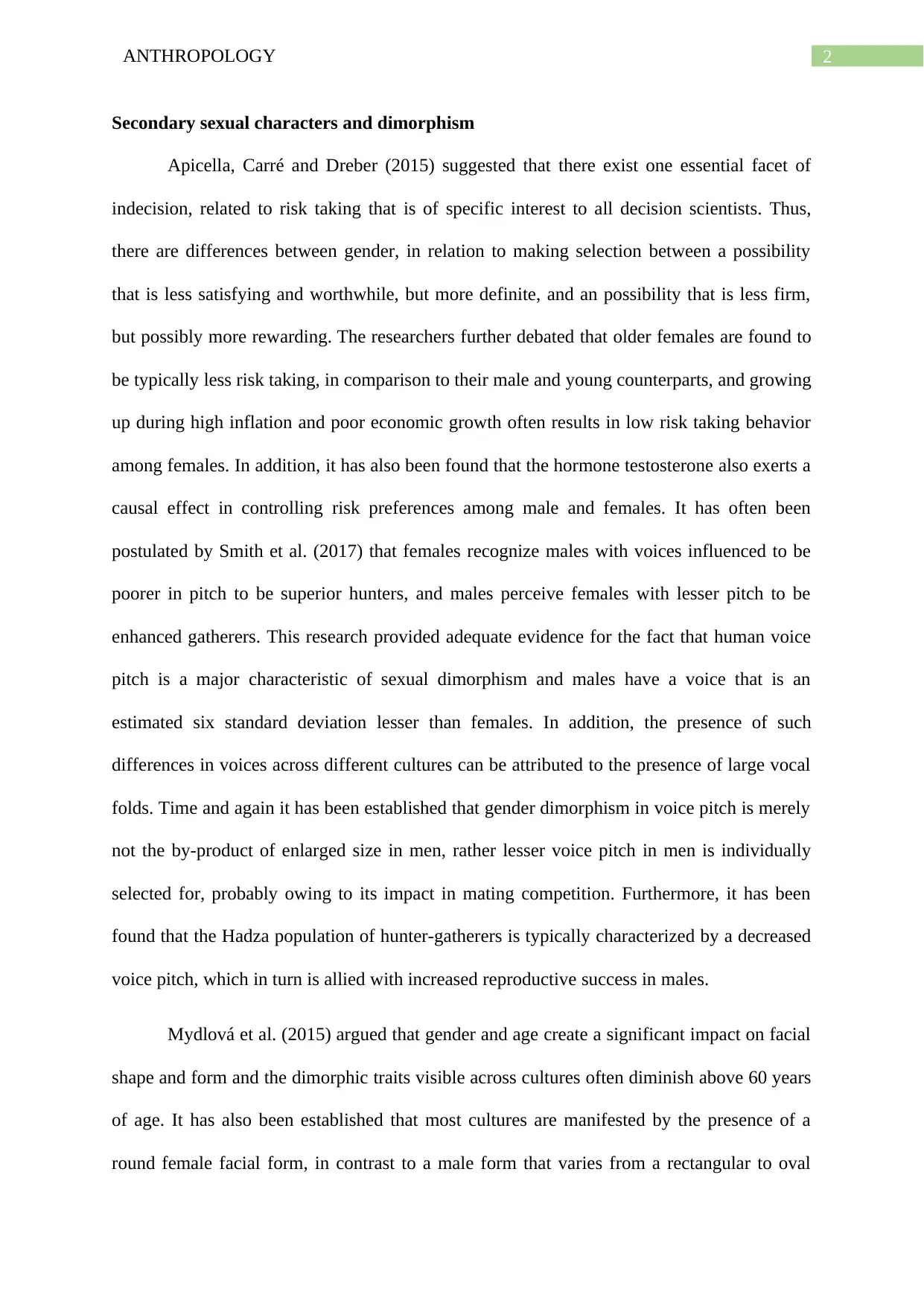
2ANTHROPOLOGY
Secondary sexual characters and dimorphism
Apicella, Carré and Dreber (2015) suggested that there exist one essential facet of
indecision, related to risk taking that is of specific interest to all decision scientists. Thus,
there are differences between gender, in relation to making selection between a possibility
that is less satisfying and worthwhile, but more definite, and an possibility that is less firm,
but possibly more rewarding. The researchers further debated that older females are found to
be typically less risk taking, in comparison to their male and young counterparts, and growing
up during high inflation and poor economic growth often results in low risk taking behavior
among females. In addition, it has also been found that the hormone testosterone also exerts a
causal effect in controlling risk preferences among male and females. It has often been
postulated by Smith et al. (2017) that females recognize males with voices influenced to be
poorer in pitch to be superior hunters, and males perceive females with lesser pitch to be
enhanced gatherers. This research provided adequate evidence for the fact that human voice
pitch is a major characteristic of sexual dimorphism and males have a voice that is an
estimated six standard deviation lesser than females. In addition, the presence of such
differences in voices across different cultures can be attributed to the presence of large vocal
folds. Time and again it has been established that gender dimorphism in voice pitch is merely
not the by-product of enlarged size in men, rather lesser voice pitch in men is individually
selected for, probably owing to its impact in mating competition. Furthermore, it has been
found that the Hadza population of hunter-gatherers is typically characterized by a decreased
voice pitch, which in turn is allied with increased reproductive success in males.
Mydlová et al. (2015) argued that gender and age create a significant impact on facial
shape and form and the dimorphic traits visible across cultures often diminish above 60 years
of age. It has also been established that most cultures are manifested by the presence of a
round female facial form, in contrast to a male form that varies from a rectangular to oval
Secondary sexual characters and dimorphism
Apicella, Carré and Dreber (2015) suggested that there exist one essential facet of
indecision, related to risk taking that is of specific interest to all decision scientists. Thus,
there are differences between gender, in relation to making selection between a possibility
that is less satisfying and worthwhile, but more definite, and an possibility that is less firm,
but possibly more rewarding. The researchers further debated that older females are found to
be typically less risk taking, in comparison to their male and young counterparts, and growing
up during high inflation and poor economic growth often results in low risk taking behavior
among females. In addition, it has also been found that the hormone testosterone also exerts a
causal effect in controlling risk preferences among male and females. It has often been
postulated by Smith et al. (2017) that females recognize males with voices influenced to be
poorer in pitch to be superior hunters, and males perceive females with lesser pitch to be
enhanced gatherers. This research provided adequate evidence for the fact that human voice
pitch is a major characteristic of sexual dimorphism and males have a voice that is an
estimated six standard deviation lesser than females. In addition, the presence of such
differences in voices across different cultures can be attributed to the presence of large vocal
folds. Time and again it has been established that gender dimorphism in voice pitch is merely
not the by-product of enlarged size in men, rather lesser voice pitch in men is individually
selected for, probably owing to its impact in mating competition. Furthermore, it has been
found that the Hadza population of hunter-gatherers is typically characterized by a decreased
voice pitch, which in turn is allied with increased reproductive success in males.
Mydlová et al. (2015) argued that gender and age create a significant impact on facial
shape and form and the dimorphic traits visible across cultures often diminish above 60 years
of age. It has also been established that most cultures are manifested by the presence of a
round female facial form, in contrast to a male form that varies from a rectangular to oval
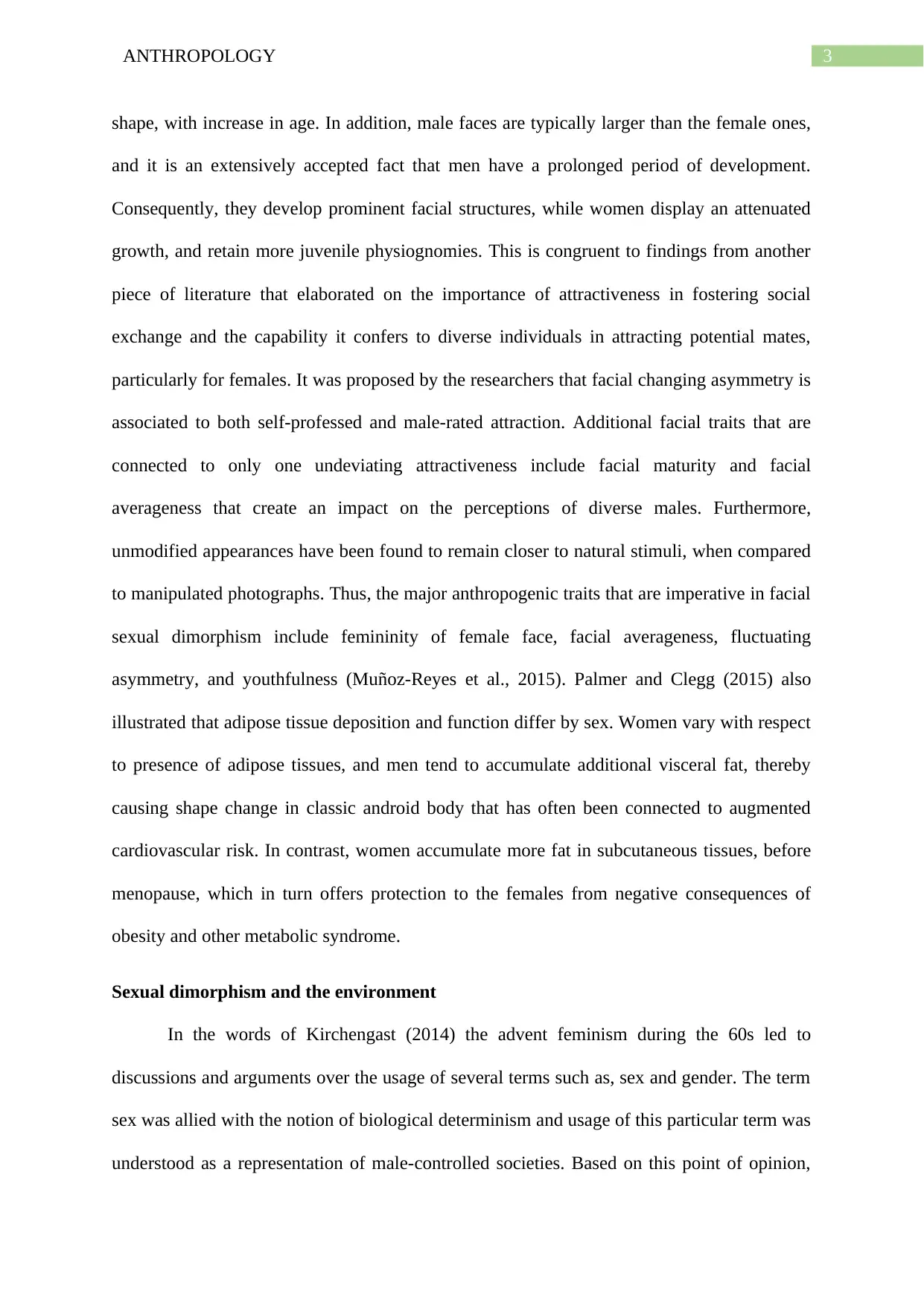
3ANTHROPOLOGY
shape, with increase in age. In addition, male faces are typically larger than the female ones,
and it is an extensively accepted fact that men have a prolonged period of development.
Consequently, they develop prominent facial structures, while women display an attenuated
growth, and retain more juvenile physiognomies. This is congruent to findings from another
piece of literature that elaborated on the importance of attractiveness in fostering social
exchange and the capability it confers to diverse individuals in attracting potential mates,
particularly for females. It was proposed by the researchers that facial changing asymmetry is
associated to both self-professed and male-rated attraction. Additional facial traits that are
connected to only one undeviating attractiveness include facial maturity and facial
averageness that create an impact on the perceptions of diverse males. Furthermore,
unmodified appearances have been found to remain closer to natural stimuli, when compared
to manipulated photographs. Thus, the major anthropogenic traits that are imperative in facial
sexual dimorphism include femininity of female face, facial averageness, fluctuating
asymmetry, and youthfulness (Muñoz-Reyes et al., 2015). Palmer and Clegg (2015) also
illustrated that adipose tissue deposition and function differ by sex. Women vary with respect
to presence of adipose tissues, and men tend to accumulate additional visceral fat, thereby
causing shape change in classic android body that has often been connected to augmented
cardiovascular risk. In contrast, women accumulate more fat in subcutaneous tissues, before
menopause, which in turn offers protection to the females from negative consequences of
obesity and other metabolic syndrome.
Sexual dimorphism and the environment
In the words of Kirchengast (2014) the advent feminism during the 60s led to
discussions and arguments over the usage of several terms such as, sex and gender. The term
sex was allied with the notion of biological determinism and usage of this particular term was
understood as a representation of male-controlled societies. Based on this point of opinion,
shape, with increase in age. In addition, male faces are typically larger than the female ones,
and it is an extensively accepted fact that men have a prolonged period of development.
Consequently, they develop prominent facial structures, while women display an attenuated
growth, and retain more juvenile physiognomies. This is congruent to findings from another
piece of literature that elaborated on the importance of attractiveness in fostering social
exchange and the capability it confers to diverse individuals in attracting potential mates,
particularly for females. It was proposed by the researchers that facial changing asymmetry is
associated to both self-professed and male-rated attraction. Additional facial traits that are
connected to only one undeviating attractiveness include facial maturity and facial
averageness that create an impact on the perceptions of diverse males. Furthermore,
unmodified appearances have been found to remain closer to natural stimuli, when compared
to manipulated photographs. Thus, the major anthropogenic traits that are imperative in facial
sexual dimorphism include femininity of female face, facial averageness, fluctuating
asymmetry, and youthfulness (Muñoz-Reyes et al., 2015). Palmer and Clegg (2015) also
illustrated that adipose tissue deposition and function differ by sex. Women vary with respect
to presence of adipose tissues, and men tend to accumulate additional visceral fat, thereby
causing shape change in classic android body that has often been connected to augmented
cardiovascular risk. In contrast, women accumulate more fat in subcutaneous tissues, before
menopause, which in turn offers protection to the females from negative consequences of
obesity and other metabolic syndrome.
Sexual dimorphism and the environment
In the words of Kirchengast (2014) the advent feminism during the 60s led to
discussions and arguments over the usage of several terms such as, sex and gender. The term
sex was allied with the notion of biological determinism and usage of this particular term was
understood as a representation of male-controlled societies. Based on this point of opinion,
Secure Best Marks with AI Grader
Need help grading? Try our AI Grader for instant feedback on your assignments.
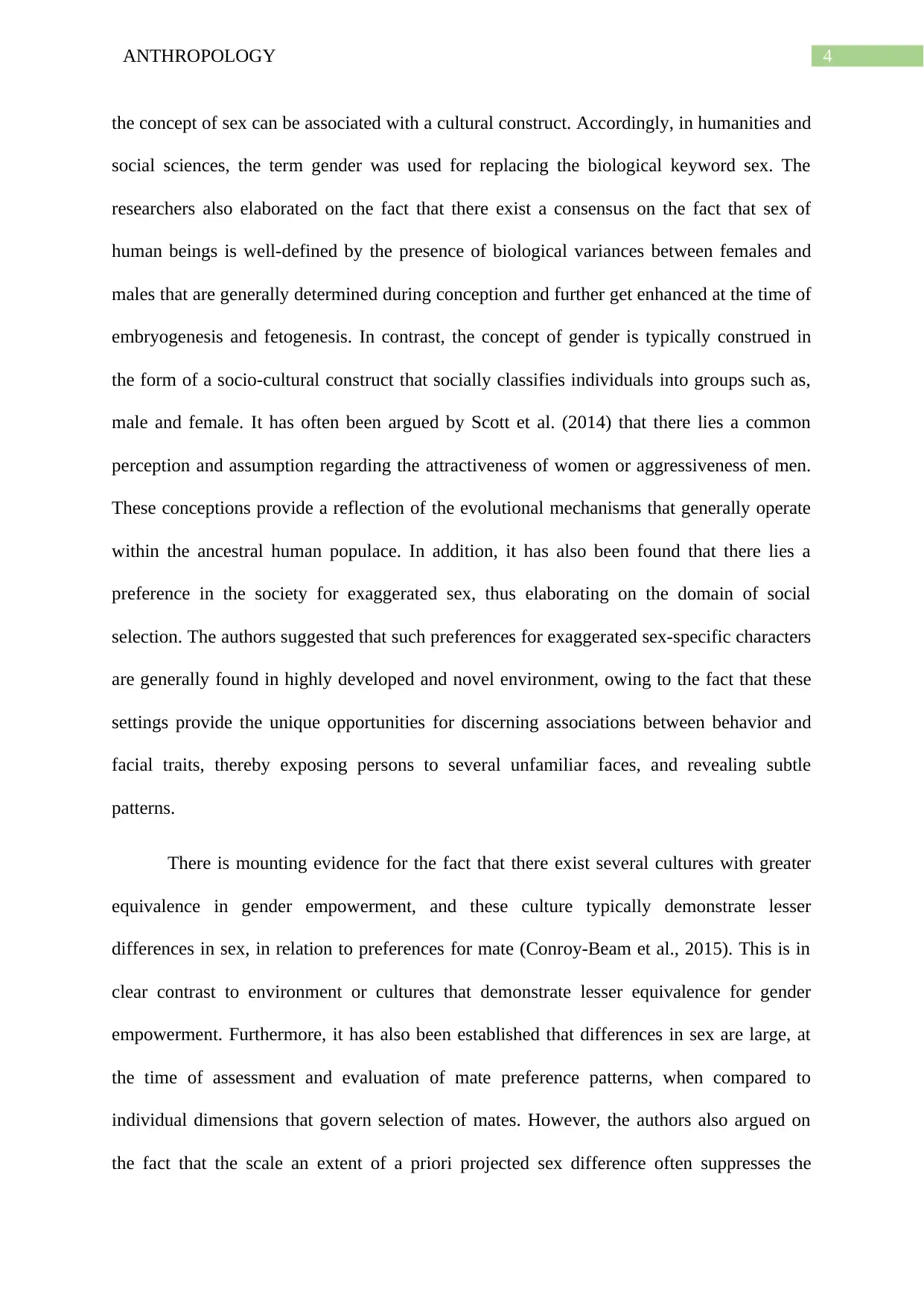
4ANTHROPOLOGY
the concept of sex can be associated with a cultural construct. Accordingly, in humanities and
social sciences, the term gender was used for replacing the biological keyword sex. The
researchers also elaborated on the fact that there exist a consensus on the fact that sex of
human beings is well-defined by the presence of biological variances between females and
males that are generally determined during conception and further get enhanced at the time of
embryogenesis and fetogenesis. In contrast, the concept of gender is typically construed in
the form of a socio-cultural construct that socially classifies individuals into groups such as,
male and female. It has often been argued by Scott et al. (2014) that there lies a common
perception and assumption regarding the attractiveness of women or aggressiveness of men.
These conceptions provide a reflection of the evolutional mechanisms that generally operate
within the ancestral human populace. In addition, it has also been found that there lies a
preference in the society for exaggerated sex, thus elaborating on the domain of social
selection. The authors suggested that such preferences for exaggerated sex-specific characters
are generally found in highly developed and novel environment, owing to the fact that these
settings provide the unique opportunities for discerning associations between behavior and
facial traits, thereby exposing persons to several unfamiliar faces, and revealing subtle
patterns.
There is mounting evidence for the fact that there exist several cultures with greater
equivalence in gender empowerment, and these culture typically demonstrate lesser
differences in sex, in relation to preferences for mate (Conroy-Beam et al., 2015). This is in
clear contrast to environment or cultures that demonstrate lesser equivalence for gender
empowerment. Furthermore, it has also been established that differences in sex are large, at
the time of assessment and evaluation of mate preference patterns, when compared to
individual dimensions that govern selection of mates. However, the authors also argued on
the fact that the scale an extent of a priori projected sex difference often suppresses the
the concept of sex can be associated with a cultural construct. Accordingly, in humanities and
social sciences, the term gender was used for replacing the biological keyword sex. The
researchers also elaborated on the fact that there exist a consensus on the fact that sex of
human beings is well-defined by the presence of biological variances between females and
males that are generally determined during conception and further get enhanced at the time of
embryogenesis and fetogenesis. In contrast, the concept of gender is typically construed in
the form of a socio-cultural construct that socially classifies individuals into groups such as,
male and female. It has often been argued by Scott et al. (2014) that there lies a common
perception and assumption regarding the attractiveness of women or aggressiveness of men.
These conceptions provide a reflection of the evolutional mechanisms that generally operate
within the ancestral human populace. In addition, it has also been found that there lies a
preference in the society for exaggerated sex, thus elaborating on the domain of social
selection. The authors suggested that such preferences for exaggerated sex-specific characters
are generally found in highly developed and novel environment, owing to the fact that these
settings provide the unique opportunities for discerning associations between behavior and
facial traits, thereby exposing persons to several unfamiliar faces, and revealing subtle
patterns.
There is mounting evidence for the fact that there exist several cultures with greater
equivalence in gender empowerment, and these culture typically demonstrate lesser
differences in sex, in relation to preferences for mate (Conroy-Beam et al., 2015). This is in
clear contrast to environment or cultures that demonstrate lesser equivalence for gender
empowerment. Furthermore, it has also been established that differences in sex are large, at
the time of assessment and evaluation of mate preference patterns, when compared to
individual dimensions that govern selection of mates. However, the authors also argued on
the fact that the scale an extent of a priori projected sex difference often suppresses the
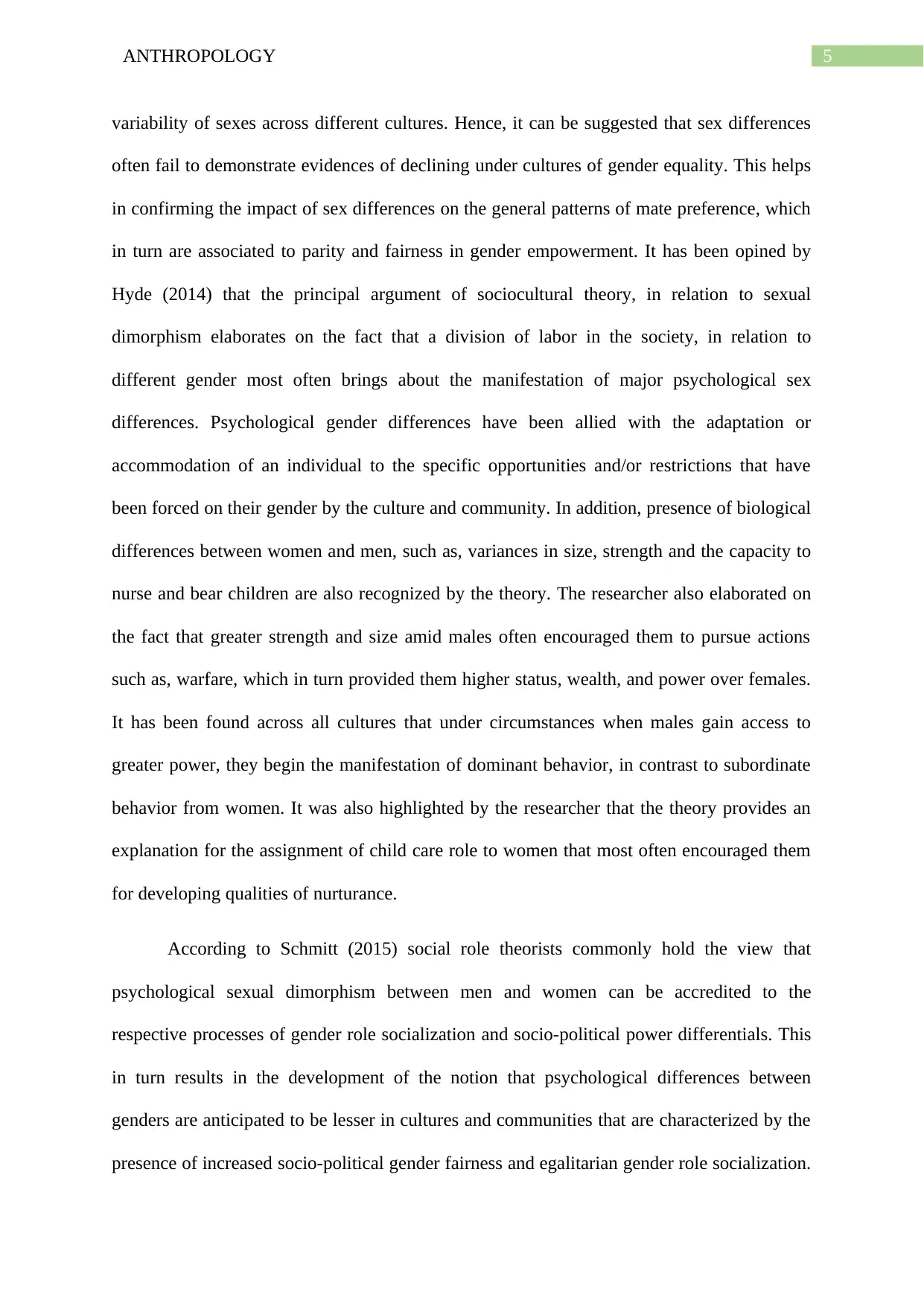
5ANTHROPOLOGY
variability of sexes across different cultures. Hence, it can be suggested that sex differences
often fail to demonstrate evidences of declining under cultures of gender equality. This helps
in confirming the impact of sex differences on the general patterns of mate preference, which
in turn are associated to parity and fairness in gender empowerment. It has been opined by
Hyde (2014) that the principal argument of sociocultural theory, in relation to sexual
dimorphism elaborates on the fact that a division of labor in the society, in relation to
different gender most often brings about the manifestation of major psychological sex
differences. Psychological gender differences have been allied with the adaptation or
accommodation of an individual to the specific opportunities and/or restrictions that have
been forced on their gender by the culture and community. In addition, presence of biological
differences between women and men, such as, variances in size, strength and the capacity to
nurse and bear children are also recognized by the theory. The researcher also elaborated on
the fact that greater strength and size amid males often encouraged them to pursue actions
such as, warfare, which in turn provided them higher status, wealth, and power over females.
It has been found across all cultures that under circumstances when males gain access to
greater power, they begin the manifestation of dominant behavior, in contrast to subordinate
behavior from women. It was also highlighted by the researcher that the theory provides an
explanation for the assignment of child care role to women that most often encouraged them
for developing qualities of nurturance.
According to Schmitt (2015) social role theorists commonly hold the view that
psychological sexual dimorphism between men and women can be accredited to the
respective processes of gender role socialization and socio-political power differentials. This
in turn results in the development of the notion that psychological differences between
genders are anticipated to be lesser in cultures and communities that are characterized by the
presence of increased socio-political gender fairness and egalitarian gender role socialization.
variability of sexes across different cultures. Hence, it can be suggested that sex differences
often fail to demonstrate evidences of declining under cultures of gender equality. This helps
in confirming the impact of sex differences on the general patterns of mate preference, which
in turn are associated to parity and fairness in gender empowerment. It has been opined by
Hyde (2014) that the principal argument of sociocultural theory, in relation to sexual
dimorphism elaborates on the fact that a division of labor in the society, in relation to
different gender most often brings about the manifestation of major psychological sex
differences. Psychological gender differences have been allied with the adaptation or
accommodation of an individual to the specific opportunities and/or restrictions that have
been forced on their gender by the culture and community. In addition, presence of biological
differences between women and men, such as, variances in size, strength and the capacity to
nurse and bear children are also recognized by the theory. The researcher also elaborated on
the fact that greater strength and size amid males often encouraged them to pursue actions
such as, warfare, which in turn provided them higher status, wealth, and power over females.
It has been found across all cultures that under circumstances when males gain access to
greater power, they begin the manifestation of dominant behavior, in contrast to subordinate
behavior from women. It was also highlighted by the researcher that the theory provides an
explanation for the assignment of child care role to women that most often encouraged them
for developing qualities of nurturance.
According to Schmitt (2015) social role theorists commonly hold the view that
psychological sexual dimorphism between men and women can be accredited to the
respective processes of gender role socialization and socio-political power differentials. This
in turn results in the development of the notion that psychological differences between
genders are anticipated to be lesser in cultures and communities that are characterized by the
presence of increased socio-political gender fairness and egalitarian gender role socialization.
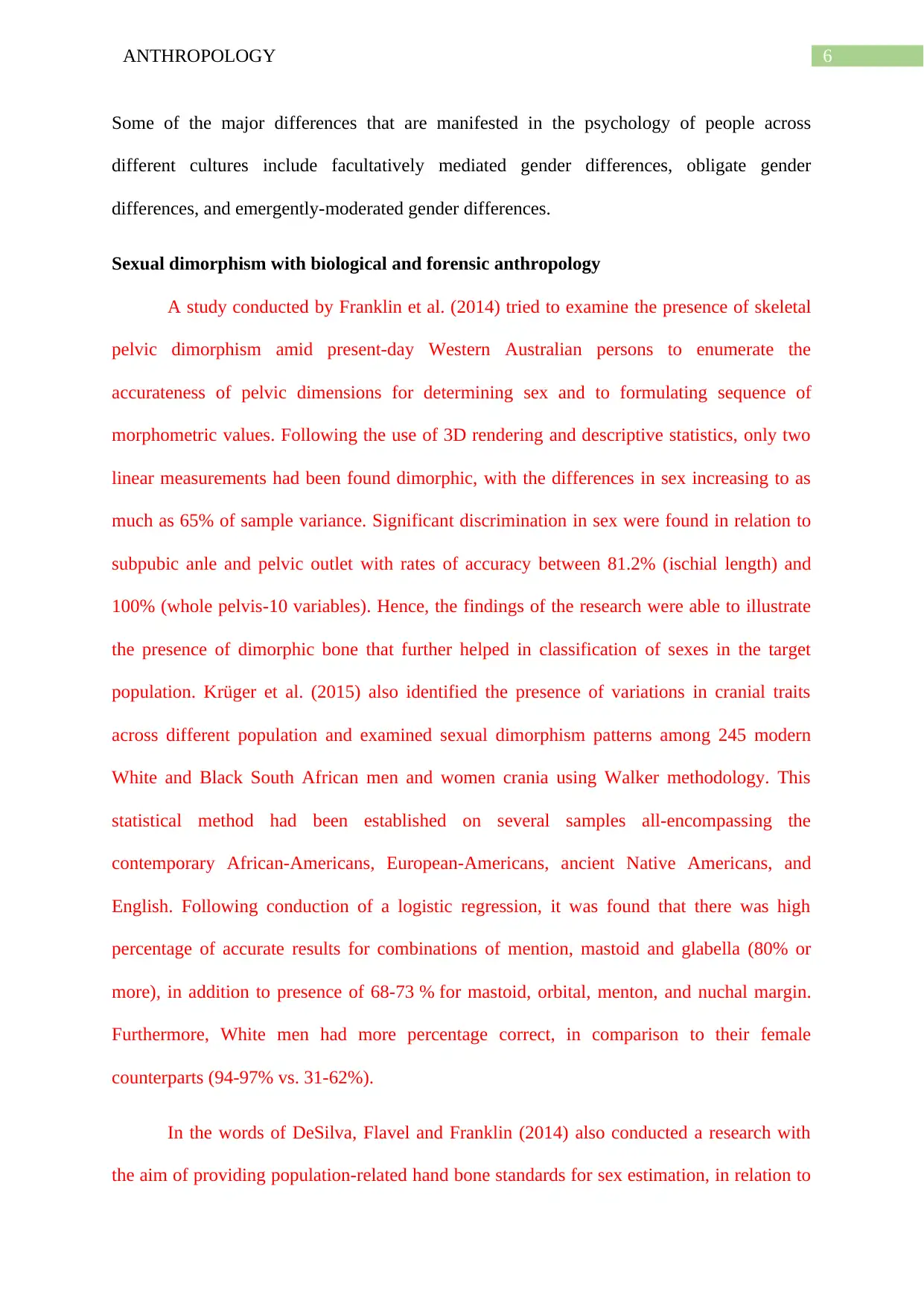
6ANTHROPOLOGY
Some of the major differences that are manifested in the psychology of people across
different cultures include facultatively mediated gender differences, obligate gender
differences, and emergently-moderated gender differences.
Sexual dimorphism with biological and forensic anthropology
A study conducted by Franklin et al. (2014) tried to examine the presence of skeletal
pelvic dimorphism amid present-day Western Australian persons to enumerate the
accurateness of pelvic dimensions for determining sex and to formulating sequence of
morphometric values. Following the use of 3D rendering and descriptive statistics, only two
linear measurements had been found dimorphic, with the differences in sex increasing to as
much as 65% of sample variance. Significant discrimination in sex were found in relation to
subpubic anle and pelvic outlet with rates of accuracy between 81.2% (ischial length) and
100% (whole pelvis-10 variables). Hence, the findings of the research were able to illustrate
the presence of dimorphic bone that further helped in classification of sexes in the target
population. Krüger et al. (2015) also identified the presence of variations in cranial traits
across different population and examined sexual dimorphism patterns among 245 modern
White and Black South African men and women crania using Walker methodology. This
statistical method had been established on several samples all-encompassing the
contemporary African-Americans, European-Americans, ancient Native Americans, and
English. Following conduction of a logistic regression, it was found that there was high
percentage of accurate results for combinations of mention, mastoid and glabella (80% or
more), in addition to presence of 68-73 % for mastoid, orbital, menton, and nuchal margin.
Furthermore, White men had more percentage correct, in comparison to their female
counterparts (94-97% vs. 31-62%).
In the words of DeSilva, Flavel and Franklin (2014) also conducted a research with
the aim of providing population-related hand bone standards for sex estimation, in relation to
Some of the major differences that are manifested in the psychology of people across
different cultures include facultatively mediated gender differences, obligate gender
differences, and emergently-moderated gender differences.
Sexual dimorphism with biological and forensic anthropology
A study conducted by Franklin et al. (2014) tried to examine the presence of skeletal
pelvic dimorphism amid present-day Western Australian persons to enumerate the
accurateness of pelvic dimensions for determining sex and to formulating sequence of
morphometric values. Following the use of 3D rendering and descriptive statistics, only two
linear measurements had been found dimorphic, with the differences in sex increasing to as
much as 65% of sample variance. Significant discrimination in sex were found in relation to
subpubic anle and pelvic outlet with rates of accuracy between 81.2% (ischial length) and
100% (whole pelvis-10 variables). Hence, the findings of the research were able to illustrate
the presence of dimorphic bone that further helped in classification of sexes in the target
population. Krüger et al. (2015) also identified the presence of variations in cranial traits
across different population and examined sexual dimorphism patterns among 245 modern
White and Black South African men and women crania using Walker methodology. This
statistical method had been established on several samples all-encompassing the
contemporary African-Americans, European-Americans, ancient Native Americans, and
English. Following conduction of a logistic regression, it was found that there was high
percentage of accurate results for combinations of mention, mastoid and glabella (80% or
more), in addition to presence of 68-73 % for mastoid, orbital, menton, and nuchal margin.
Furthermore, White men had more percentage correct, in comparison to their female
counterparts (94-97% vs. 31-62%).
In the words of DeSilva, Flavel and Franklin (2014) also conducted a research with
the aim of providing population-related hand bone standards for sex estimation, in relation to
Paraphrase This Document
Need a fresh take? Get an instant paraphrase of this document with our AI Paraphraser

7ANTHROPOLOGY
the present Western Australian individuals. On examining the right hand of the participants
by using radiographs, the findings provided evidence for the fact that almost all
measurements of hand bone were meaningfully sexually dimorphic, with a propensity among
the width dimensions of expressing an increased degree of dimorphism, when compared to
the length dimensions. The findings elaborated on the presence of 91% accuracy, with -6%
sex bias among the participants, thereby validating the presence of sexual dimorphism. de
Oliveira Gamba, Alves and Haiter-Neto (2016) also aimed to evaluate the presence of sexual
dimorphism by utilising anthropometric measurements that were related to mandibular
graphics, obtained by conducting CBCT. After collection of CT scans from 86 women and 74
men who belonged to the Brazilian population, the researchers analysed the images, which
encompassed gonion–gnathion length, ramus length, bicondylar breadth, gonial angle,
minimum ramus breadth, and bigonial breadth. With the use of four different variables, there
was 95.1% rate of accurate sex classification which in turn was concomitant with 94.74% and
93.33% for the estimated women and men, respectively.
Likewise, Clavero, Salicrú and Turbón (2015) tried to predict the sex of Spanish
population, based on CT images of hip bone and femur and found that there was 98.3%
correct classification, following the use of three explanatory variables namely, HDH, VDH,
and MIB. In addition, the findings also helped the researchers to elaborate on the fact that
conducting anthropological examinations in imperative in order to determine the presence of
sexual dimorphism, with respect to bone differences between males and females, of a
particular population. This was in accordance to findings from another research that was
based on estimates sex differences, on conducting a scapula analysis in a target Japanese
population. The researchers conducted the examination on an estimated 218 cadavers that
comprised of 109 females and 109 males. On conducting scapular measurements,
dimorphism was found in all variables, with accurate rates in sex classification being roughly
the present Western Australian individuals. On examining the right hand of the participants
by using radiographs, the findings provided evidence for the fact that almost all
measurements of hand bone were meaningfully sexually dimorphic, with a propensity among
the width dimensions of expressing an increased degree of dimorphism, when compared to
the length dimensions. The findings elaborated on the presence of 91% accuracy, with -6%
sex bias among the participants, thereby validating the presence of sexual dimorphism. de
Oliveira Gamba, Alves and Haiter-Neto (2016) also aimed to evaluate the presence of sexual
dimorphism by utilising anthropometric measurements that were related to mandibular
graphics, obtained by conducting CBCT. After collection of CT scans from 86 women and 74
men who belonged to the Brazilian population, the researchers analysed the images, which
encompassed gonion–gnathion length, ramus length, bicondylar breadth, gonial angle,
minimum ramus breadth, and bigonial breadth. With the use of four different variables, there
was 95.1% rate of accurate sex classification which in turn was concomitant with 94.74% and
93.33% for the estimated women and men, respectively.
Likewise, Clavero, Salicrú and Turbón (2015) tried to predict the sex of Spanish
population, based on CT images of hip bone and femur and found that there was 98.3%
correct classification, following the use of three explanatory variables namely, HDH, VDH,
and MIB. In addition, the findings also helped the researchers to elaborate on the fact that
conducting anthropological examinations in imperative in order to determine the presence of
sexual dimorphism, with respect to bone differences between males and females, of a
particular population. This was in accordance to findings from another research that was
based on estimates sex differences, on conducting a scapula analysis in a target Japanese
population. The researchers conducted the examination on an estimated 218 cadavers that
comprised of 109 females and 109 males. On conducting scapular measurements,
dimorphism was found in all variables, with accurate rates in sex classification being roughly
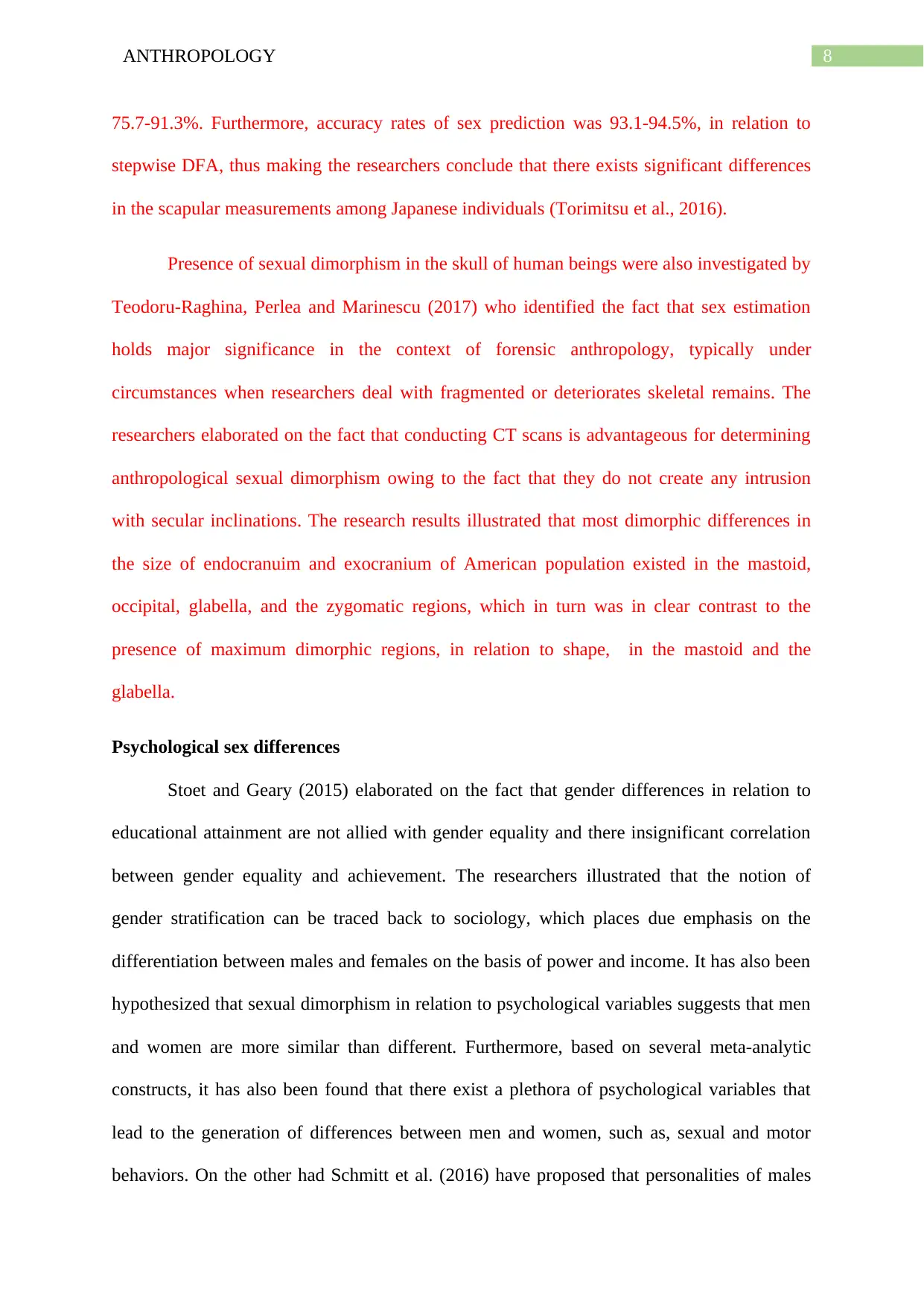
8ANTHROPOLOGY
75.7-91.3%. Furthermore, accuracy rates of sex prediction was 93.1-94.5%, in relation to
stepwise DFA, thus making the researchers conclude that there exists significant differences
in the scapular measurements among Japanese individuals (Torimitsu et al., 2016).
Presence of sexual dimorphism in the skull of human beings were also investigated by
Teodoru-Raghina, Perlea and Marinescu (2017) who identified the fact that sex estimation
holds major significance in the context of forensic anthropology, typically under
circumstances when researchers deal with fragmented or deteriorates skeletal remains. The
researchers elaborated on the fact that conducting CT scans is advantageous for determining
anthropological sexual dimorphism owing to the fact that they do not create any intrusion
with secular inclinations. The research results illustrated that most dimorphic differences in
the size of endocranuim and exocranium of American population existed in the mastoid,
occipital, glabella, and the zygomatic regions, which in turn was in clear contrast to the
presence of maximum dimorphic regions, in relation to shape, in the mastoid and the
glabella.
Psychological sex differences
Stoet and Geary (2015) elaborated on the fact that gender differences in relation to
educational attainment are not allied with gender equality and there insignificant correlation
between gender equality and achievement. The researchers illustrated that the notion of
gender stratification can be traced back to sociology, which places due emphasis on the
differentiation between males and females on the basis of power and income. It has also been
hypothesized that sexual dimorphism in relation to psychological variables suggests that men
and women are more similar than different. Furthermore, based on several meta-analytic
constructs, it has also been found that there exist a plethora of psychological variables that
lead to the generation of differences between men and women, such as, sexual and motor
behaviors. On the other had Schmitt et al. (2016) have proposed that personalities of males
75.7-91.3%. Furthermore, accuracy rates of sex prediction was 93.1-94.5%, in relation to
stepwise DFA, thus making the researchers conclude that there exists significant differences
in the scapular measurements among Japanese individuals (Torimitsu et al., 2016).
Presence of sexual dimorphism in the skull of human beings were also investigated by
Teodoru-Raghina, Perlea and Marinescu (2017) who identified the fact that sex estimation
holds major significance in the context of forensic anthropology, typically under
circumstances when researchers deal with fragmented or deteriorates skeletal remains. The
researchers elaborated on the fact that conducting CT scans is advantageous for determining
anthropological sexual dimorphism owing to the fact that they do not create any intrusion
with secular inclinations. The research results illustrated that most dimorphic differences in
the size of endocranuim and exocranium of American population existed in the mastoid,
occipital, glabella, and the zygomatic regions, which in turn was in clear contrast to the
presence of maximum dimorphic regions, in relation to shape, in the mastoid and the
glabella.
Psychological sex differences
Stoet and Geary (2015) elaborated on the fact that gender differences in relation to
educational attainment are not allied with gender equality and there insignificant correlation
between gender equality and achievement. The researchers illustrated that the notion of
gender stratification can be traced back to sociology, which places due emphasis on the
differentiation between males and females on the basis of power and income. It has also been
hypothesized that sexual dimorphism in relation to psychological variables suggests that men
and women are more similar than different. Furthermore, based on several meta-analytic
constructs, it has also been found that there exist a plethora of psychological variables that
lead to the generation of differences between men and women, such as, sexual and motor
behaviors. On the other had Schmitt et al. (2016) have proposed that personalities of males
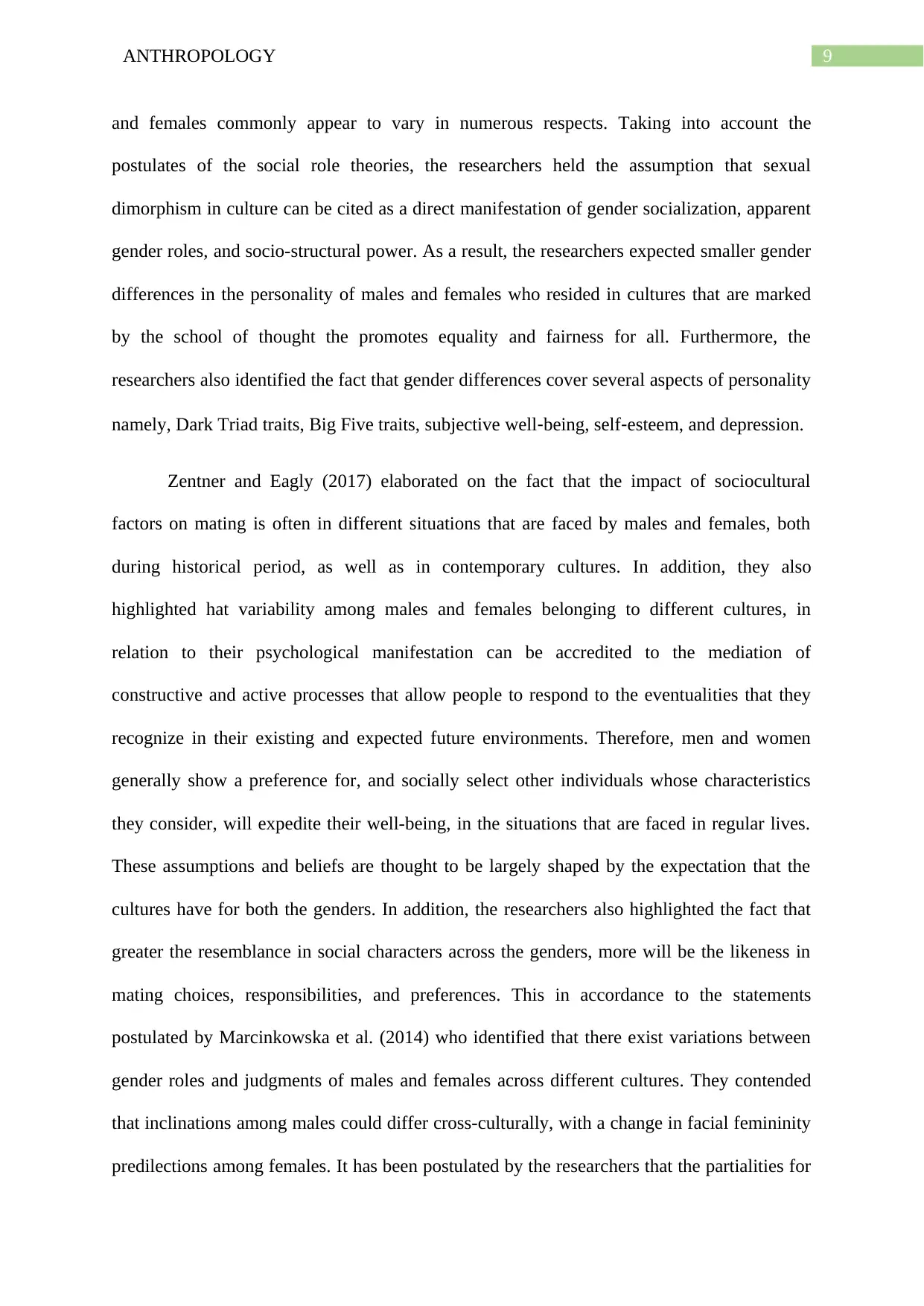
9ANTHROPOLOGY
and females commonly appear to vary in numerous respects. Taking into account the
postulates of the social role theories, the researchers held the assumption that sexual
dimorphism in culture can be cited as a direct manifestation of gender socialization, apparent
gender roles, and socio-structural power. As a result, the researchers expected smaller gender
differences in the personality of males and females who resided in cultures that are marked
by the school of thought the promotes equality and fairness for all. Furthermore, the
researchers also identified the fact that gender differences cover several aspects of personality
namely, Dark Triad traits, Big Five traits, subjective well‐being, self‐esteem, and depression.
Zentner and Eagly (2017) elaborated on the fact that the impact of sociocultural
factors on mating is often in different situations that are faced by males and females, both
during historical period, as well as in contemporary cultures. In addition, they also
highlighted hat variability among males and females belonging to different cultures, in
relation to their psychological manifestation can be accredited to the mediation of
constructive and active processes that allow people to respond to the eventualities that they
recognize in their existing and expected future environments. Therefore, men and women
generally show a preference for, and socially select other individuals whose characteristics
they consider, will expedite their well-being, in the situations that are faced in regular lives.
These assumptions and beliefs are thought to be largely shaped by the expectation that the
cultures have for both the genders. In addition, the researchers also highlighted the fact that
greater the resemblance in social characters across the genders, more will be the likeness in
mating choices, responsibilities, and preferences. This in accordance to the statements
postulated by Marcinkowska et al. (2014) who identified that there exist variations between
gender roles and judgments of males and females across different cultures. They contended
that inclinations among males could differ cross-culturally, with a change in facial femininity
predilections among females. It has been postulated by the researchers that the partialities for
and females commonly appear to vary in numerous respects. Taking into account the
postulates of the social role theories, the researchers held the assumption that sexual
dimorphism in culture can be cited as a direct manifestation of gender socialization, apparent
gender roles, and socio-structural power. As a result, the researchers expected smaller gender
differences in the personality of males and females who resided in cultures that are marked
by the school of thought the promotes equality and fairness for all. Furthermore, the
researchers also identified the fact that gender differences cover several aspects of personality
namely, Dark Triad traits, Big Five traits, subjective well‐being, self‐esteem, and depression.
Zentner and Eagly (2017) elaborated on the fact that the impact of sociocultural
factors on mating is often in different situations that are faced by males and females, both
during historical period, as well as in contemporary cultures. In addition, they also
highlighted hat variability among males and females belonging to different cultures, in
relation to their psychological manifestation can be accredited to the mediation of
constructive and active processes that allow people to respond to the eventualities that they
recognize in their existing and expected future environments. Therefore, men and women
generally show a preference for, and socially select other individuals whose characteristics
they consider, will expedite their well-being, in the situations that are faced in regular lives.
These assumptions and beliefs are thought to be largely shaped by the expectation that the
cultures have for both the genders. In addition, the researchers also highlighted the fact that
greater the resemblance in social characters across the genders, more will be the likeness in
mating choices, responsibilities, and preferences. This in accordance to the statements
postulated by Marcinkowska et al. (2014) who identified that there exist variations between
gender roles and judgments of males and females across different cultures. They contended
that inclinations among males could differ cross-culturally, with a change in facial femininity
predilections among females. It has been postulated by the researchers that the partialities for
Secure Best Marks with AI Grader
Need help grading? Try our AI Grader for instant feedback on your assignments.
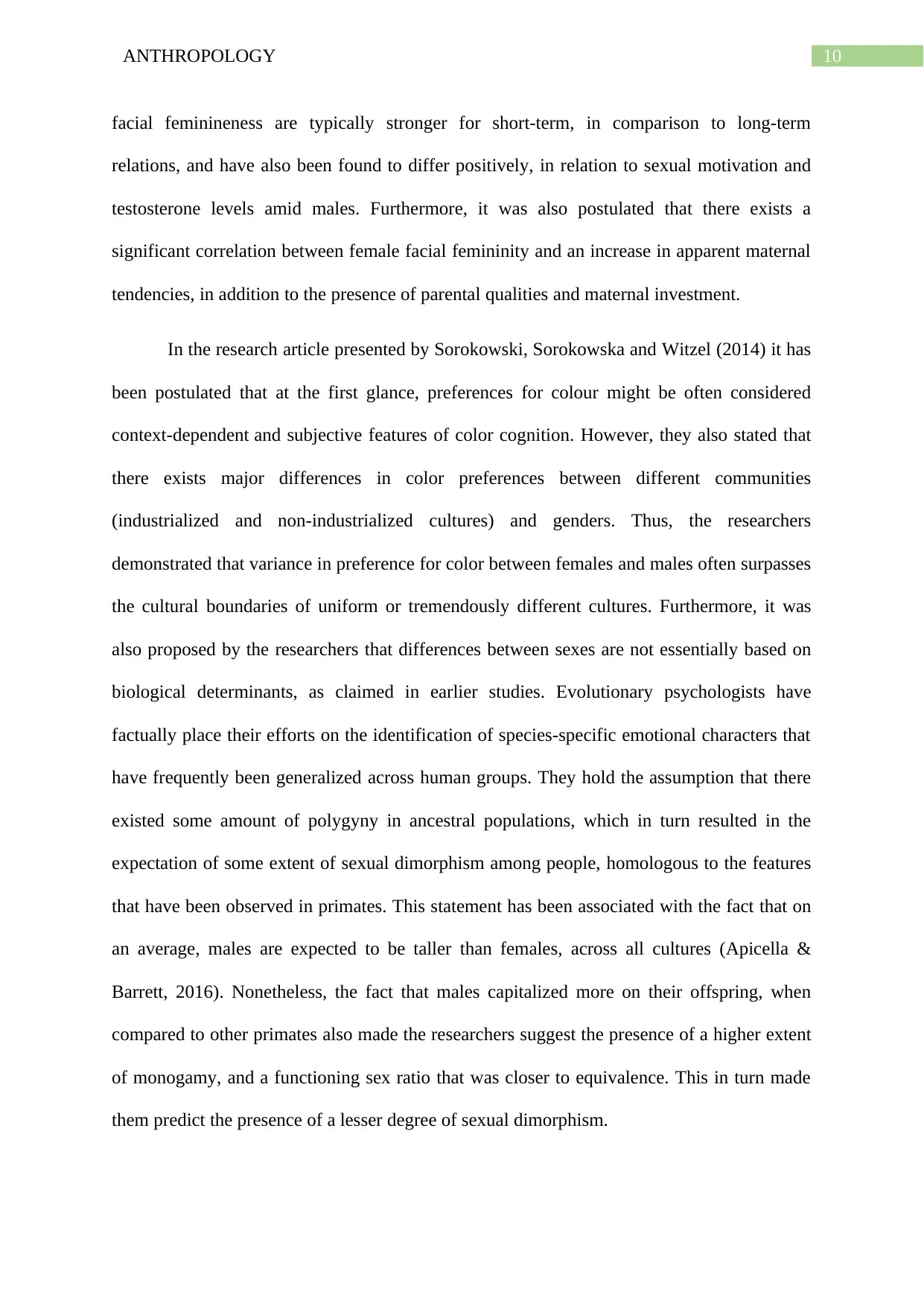
10ANTHROPOLOGY
facial feminineness are typically stronger for short-term, in comparison to long-term
relations, and have also been found to differ positively, in relation to sexual motivation and
testosterone levels amid males. Furthermore, it was also postulated that there exists a
significant correlation between female facial femininity and an increase in apparent maternal
tendencies, in addition to the presence of parental qualities and maternal investment.
In the research article presented by Sorokowski, Sorokowska and Witzel (2014) it has
been postulated that at the first glance, preferences for colour might be often considered
context-dependent and subjective features of color cognition. However, they also stated that
there exists major differences in color preferences between different communities
(industrialized and non-industrialized cultures) and genders. Thus, the researchers
demonstrated that variance in preference for color between females and males often surpasses
the cultural boundaries of uniform or tremendously different cultures. Furthermore, it was
also proposed by the researchers that differences between sexes are not essentially based on
biological determinants, as claimed in earlier studies. Evolutionary psychologists have
factually place their efforts on the identification of species-specific emotional characters that
have frequently been generalized across human groups. They hold the assumption that there
existed some amount of polygyny in ancestral populations, which in turn resulted in the
expectation of some extent of sexual dimorphism among people, homologous to the features
that have been observed in primates. This statement has been associated with the fact that on
an average, males are expected to be taller than females, across all cultures (Apicella &
Barrett, 2016). Nonetheless, the fact that males capitalized more on their offspring, when
compared to other primates also made the researchers suggest the presence of a higher extent
of monogamy, and a functioning sex ratio that was closer to equivalence. This in turn made
them predict the presence of a lesser degree of sexual dimorphism.
facial feminineness are typically stronger for short-term, in comparison to long-term
relations, and have also been found to differ positively, in relation to sexual motivation and
testosterone levels amid males. Furthermore, it was also postulated that there exists a
significant correlation between female facial femininity and an increase in apparent maternal
tendencies, in addition to the presence of parental qualities and maternal investment.
In the research article presented by Sorokowski, Sorokowska and Witzel (2014) it has
been postulated that at the first glance, preferences for colour might be often considered
context-dependent and subjective features of color cognition. However, they also stated that
there exists major differences in color preferences between different communities
(industrialized and non-industrialized cultures) and genders. Thus, the researchers
demonstrated that variance in preference for color between females and males often surpasses
the cultural boundaries of uniform or tremendously different cultures. Furthermore, it was
also proposed by the researchers that differences between sexes are not essentially based on
biological determinants, as claimed in earlier studies. Evolutionary psychologists have
factually place their efforts on the identification of species-specific emotional characters that
have frequently been generalized across human groups. They hold the assumption that there
existed some amount of polygyny in ancestral populations, which in turn resulted in the
expectation of some extent of sexual dimorphism among people, homologous to the features
that have been observed in primates. This statement has been associated with the fact that on
an average, males are expected to be taller than females, across all cultures (Apicella &
Barrett, 2016). Nonetheless, the fact that males capitalized more on their offspring, when
compared to other primates also made the researchers suggest the presence of a higher extent
of monogamy, and a functioning sex ratio that was closer to equivalence. This in turn made
them predict the presence of a lesser degree of sexual dimorphism.

11ANTHROPOLOGY
Behavioral gender differences across cultures
Apicella, Crittenden and Tobolsky (2017) also illustrated the fact that there exist
several differences, in terms of labour and economic disparities between the genders and they
might lead to the evolution of gender differences regarding risk preferences. The article
elaborated on the fact that taking into consideration the extent of challenges that men and
women had confronted in their past, it is highly conceivable that similar choices that have
been made under circumstances of uncertainty would yield dissimilar returns based on
gender. This helps in establishing the impact of natural selection on sexual dimorphism in
risk taking behavior. Thus, differences between genders, in relation to their behavior and
characteristics are a manifestation of evolutionary downstream influences in reproduction
pattern, where the costs of reproduction are considerably greater for females. The researchers
also argued that financial risk-taking attitudes can be considered as a contemporary practice
of male-male struggle for resources that habitually plays a predominant role in attracting
mates. In other words, augmented approval of risk-taking behavior in males enables male-
male opposition. Furthermore, gender difference in risk inclinations are also expected to
evolve in cultures where only men have been identified to exist above a definite pay
threshold.
Conclusion
Although there exist major differences in physiological and psychological
characteristics between males and females, across diverse cultures, most common differences
comprise of features related to reproductive role, endocrine system, risk taking behavior,
facial patterns, body weight, selection, and mate preferences. To conclude, sexual
dimorphism encompasses the general phenomenon where men and women forms generally
display dissimilar morphological features or characteristics. Furthermore, although the
concept has gained attention in recent years, there exists several controversies regarding to
Behavioral gender differences across cultures
Apicella, Crittenden and Tobolsky (2017) also illustrated the fact that there exist
several differences, in terms of labour and economic disparities between the genders and they
might lead to the evolution of gender differences regarding risk preferences. The article
elaborated on the fact that taking into consideration the extent of challenges that men and
women had confronted in their past, it is highly conceivable that similar choices that have
been made under circumstances of uncertainty would yield dissimilar returns based on
gender. This helps in establishing the impact of natural selection on sexual dimorphism in
risk taking behavior. Thus, differences between genders, in relation to their behavior and
characteristics are a manifestation of evolutionary downstream influences in reproduction
pattern, where the costs of reproduction are considerably greater for females. The researchers
also argued that financial risk-taking attitudes can be considered as a contemporary practice
of male-male struggle for resources that habitually plays a predominant role in attracting
mates. In other words, augmented approval of risk-taking behavior in males enables male-
male opposition. Furthermore, gender difference in risk inclinations are also expected to
evolve in cultures where only men have been identified to exist above a definite pay
threshold.
Conclusion
Although there exist major differences in physiological and psychological
characteristics between males and females, across diverse cultures, most common differences
comprise of features related to reproductive role, endocrine system, risk taking behavior,
facial patterns, body weight, selection, and mate preferences. To conclude, sexual
dimorphism encompasses the general phenomenon where men and women forms generally
display dissimilar morphological features or characteristics. Furthermore, although the
concept has gained attention in recent years, there exists several controversies regarding to
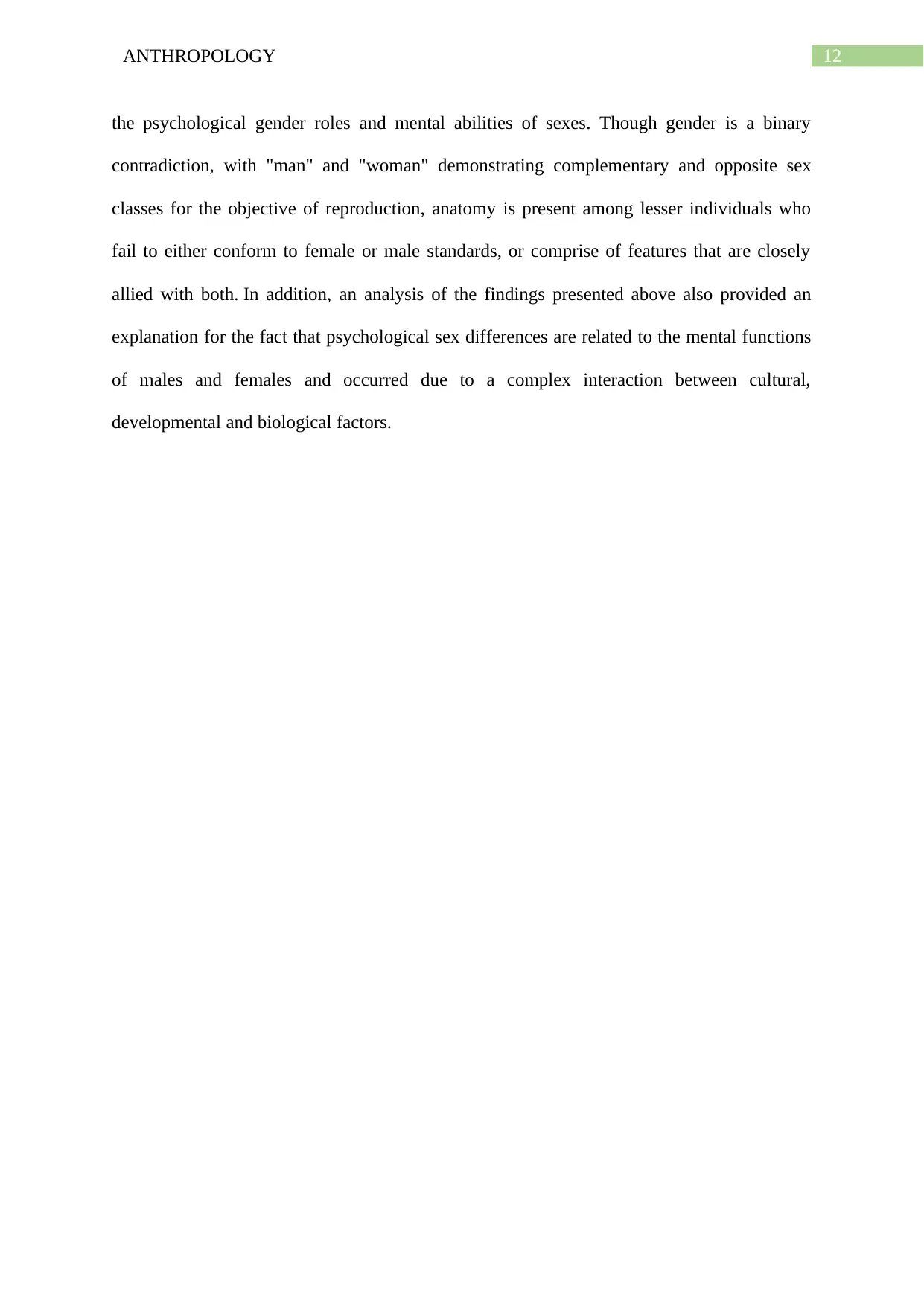
12ANTHROPOLOGY
the psychological gender roles and mental abilities of sexes. Though gender is a binary
contradiction, with "man" and "woman" demonstrating complementary and opposite sex
classes for the objective of reproduction, anatomy is present among lesser individuals who
fail to either conform to female or male standards, or comprise of features that are closely
allied with both. In addition, an analysis of the findings presented above also provided an
explanation for the fact that psychological sex differences are related to the mental functions
of males and females and occurred due to a complex interaction between cultural,
developmental and biological factors.
the psychological gender roles and mental abilities of sexes. Though gender is a binary
contradiction, with "man" and "woman" demonstrating complementary and opposite sex
classes for the objective of reproduction, anatomy is present among lesser individuals who
fail to either conform to female or male standards, or comprise of features that are closely
allied with both. In addition, an analysis of the findings presented above also provided an
explanation for the fact that psychological sex differences are related to the mental functions
of males and females and occurred due to a complex interaction between cultural,
developmental and biological factors.
Paraphrase This Document
Need a fresh take? Get an instant paraphrase of this document with our AI Paraphraser
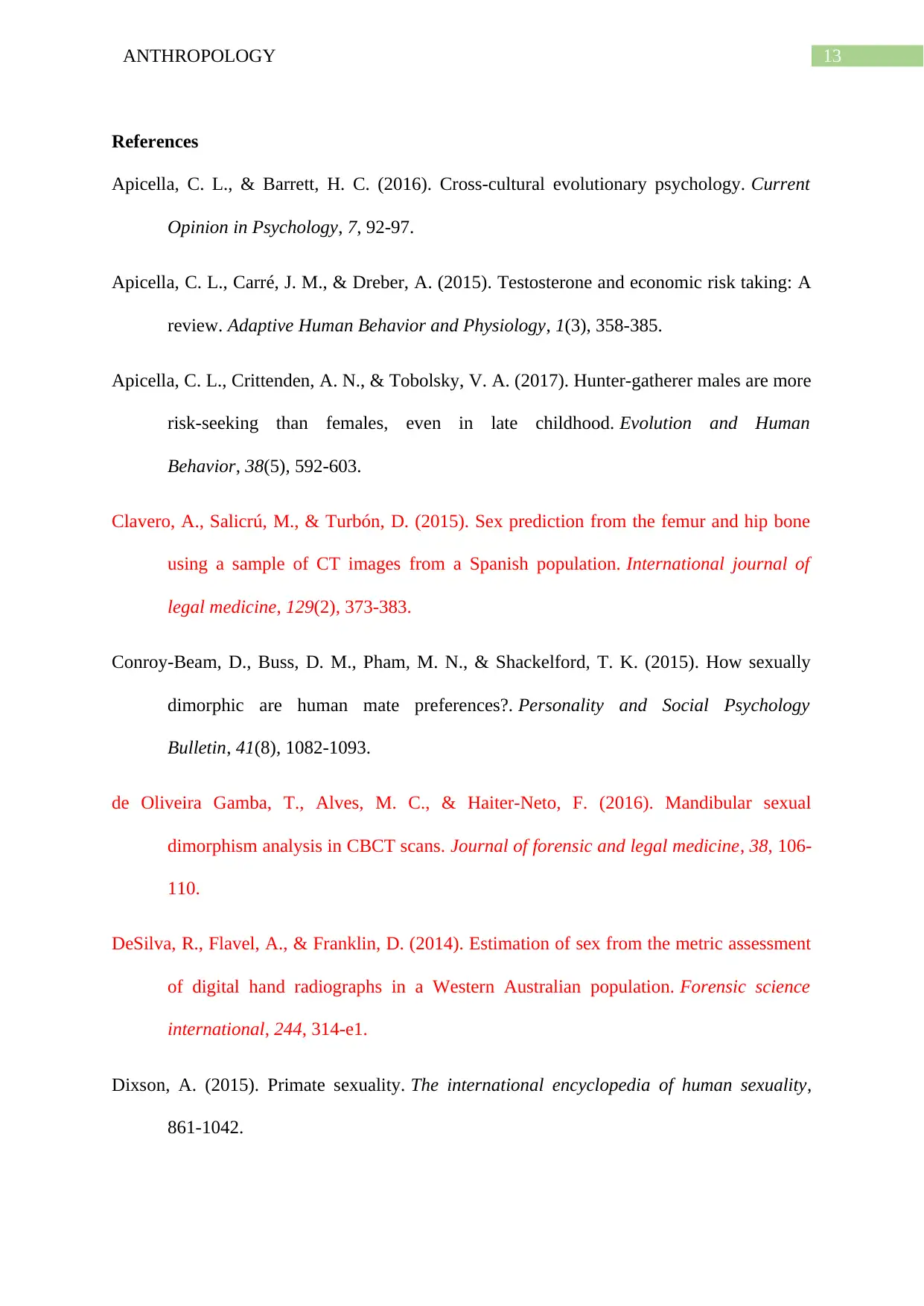
13ANTHROPOLOGY
References
Apicella, C. L., & Barrett, H. C. (2016). Cross-cultural evolutionary psychology. Current
Opinion in Psychology, 7, 92-97.
Apicella, C. L., Carré, J. M., & Dreber, A. (2015). Testosterone and economic risk taking: A
review. Adaptive Human Behavior and Physiology, 1(3), 358-385.
Apicella, C. L., Crittenden, A. N., & Tobolsky, V. A. (2017). Hunter-gatherer males are more
risk-seeking than females, even in late childhood. Evolution and Human
Behavior, 38(5), 592-603.
Clavero, A., Salicrú, M., & Turbón, D. (2015). Sex prediction from the femur and hip bone
using a sample of CT images from a Spanish population. International journal of
legal medicine, 129(2), 373-383.
Conroy-Beam, D., Buss, D. M., Pham, M. N., & Shackelford, T. K. (2015). How sexually
dimorphic are human mate preferences?. Personality and Social Psychology
Bulletin, 41(8), 1082-1093.
de Oliveira Gamba, T., Alves, M. C., & Haiter-Neto, F. (2016). Mandibular sexual
dimorphism analysis in CBCT scans. Journal of forensic and legal medicine, 38, 106-
110.
DeSilva, R., Flavel, A., & Franklin, D. (2014). Estimation of sex from the metric assessment
of digital hand radiographs in a Western Australian population. Forensic science
international, 244, 314-e1.
Dixson, A. (2015). Primate sexuality. The international encyclopedia of human sexuality,
861-1042.
References
Apicella, C. L., & Barrett, H. C. (2016). Cross-cultural evolutionary psychology. Current
Opinion in Psychology, 7, 92-97.
Apicella, C. L., Carré, J. M., & Dreber, A. (2015). Testosterone and economic risk taking: A
review. Adaptive Human Behavior and Physiology, 1(3), 358-385.
Apicella, C. L., Crittenden, A. N., & Tobolsky, V. A. (2017). Hunter-gatherer males are more
risk-seeking than females, even in late childhood. Evolution and Human
Behavior, 38(5), 592-603.
Clavero, A., Salicrú, M., & Turbón, D. (2015). Sex prediction from the femur and hip bone
using a sample of CT images from a Spanish population. International journal of
legal medicine, 129(2), 373-383.
Conroy-Beam, D., Buss, D. M., Pham, M. N., & Shackelford, T. K. (2015). How sexually
dimorphic are human mate preferences?. Personality and Social Psychology
Bulletin, 41(8), 1082-1093.
de Oliveira Gamba, T., Alves, M. C., & Haiter-Neto, F. (2016). Mandibular sexual
dimorphism analysis in CBCT scans. Journal of forensic and legal medicine, 38, 106-
110.
DeSilva, R., Flavel, A., & Franklin, D. (2014). Estimation of sex from the metric assessment
of digital hand radiographs in a Western Australian population. Forensic science
international, 244, 314-e1.
Dixson, A. (2015). Primate sexuality. The international encyclopedia of human sexuality,
861-1042.
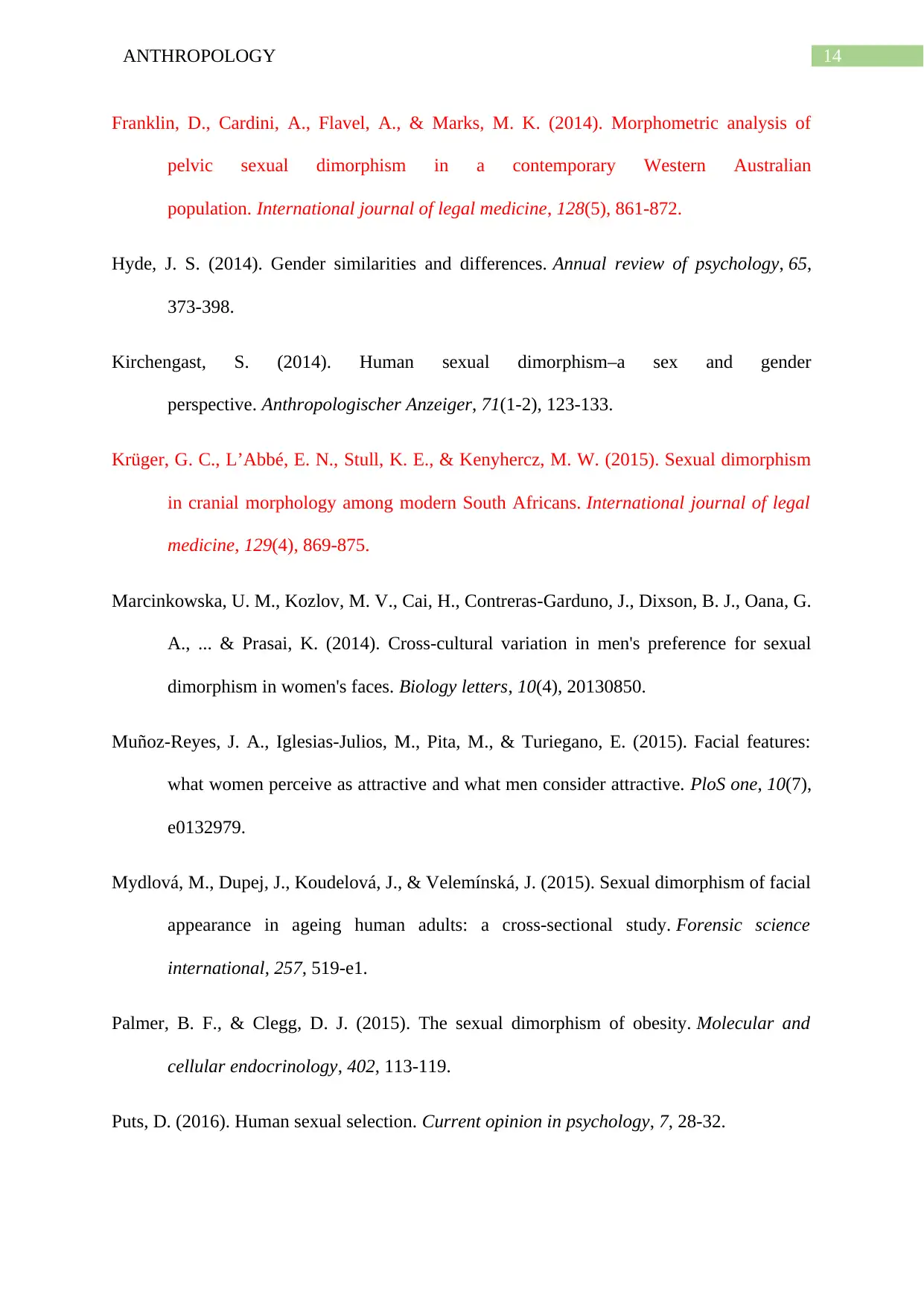
14ANTHROPOLOGY
Franklin, D., Cardini, A., Flavel, A., & Marks, M. K. (2014). Morphometric analysis of
pelvic sexual dimorphism in a contemporary Western Australian
population. International journal of legal medicine, 128(5), 861-872.
Hyde, J. S. (2014). Gender similarities and differences. Annual review of psychology, 65,
373-398.
Kirchengast, S. (2014). Human sexual dimorphism–a sex and gender
perspective. Anthropologischer Anzeiger, 71(1-2), 123-133.
Krüger, G. C., L’Abbé, E. N., Stull, K. E., & Kenyhercz, M. W. (2015). Sexual dimorphism
in cranial morphology among modern South Africans. International journal of legal
medicine, 129(4), 869-875.
Marcinkowska, U. M., Kozlov, M. V., Cai, H., Contreras-Garduno, J., Dixson, B. J., Oana, G.
A., ... & Prasai, K. (2014). Cross-cultural variation in men's preference for sexual
dimorphism in women's faces. Biology letters, 10(4), 20130850.
Muñoz-Reyes, J. A., Iglesias-Julios, M., Pita, M., & Turiegano, E. (2015). Facial features:
what women perceive as attractive and what men consider attractive. PloS one, 10(7),
e0132979.
Mydlová, M., Dupej, J., Koudelová, J., & Velemínská, J. (2015). Sexual dimorphism of facial
appearance in ageing human adults: a cross-sectional study. Forensic science
international, 257, 519-e1.
Palmer, B. F., & Clegg, D. J. (2015). The sexual dimorphism of obesity. Molecular and
cellular endocrinology, 402, 113-119.
Puts, D. (2016). Human sexual selection. Current opinion in psychology, 7, 28-32.
Franklin, D., Cardini, A., Flavel, A., & Marks, M. K. (2014). Morphometric analysis of
pelvic sexual dimorphism in a contemporary Western Australian
population. International journal of legal medicine, 128(5), 861-872.
Hyde, J. S. (2014). Gender similarities and differences. Annual review of psychology, 65,
373-398.
Kirchengast, S. (2014). Human sexual dimorphism–a sex and gender
perspective. Anthropologischer Anzeiger, 71(1-2), 123-133.
Krüger, G. C., L’Abbé, E. N., Stull, K. E., & Kenyhercz, M. W. (2015). Sexual dimorphism
in cranial morphology among modern South Africans. International journal of legal
medicine, 129(4), 869-875.
Marcinkowska, U. M., Kozlov, M. V., Cai, H., Contreras-Garduno, J., Dixson, B. J., Oana, G.
A., ... & Prasai, K. (2014). Cross-cultural variation in men's preference for sexual
dimorphism in women's faces. Biology letters, 10(4), 20130850.
Muñoz-Reyes, J. A., Iglesias-Julios, M., Pita, M., & Turiegano, E. (2015). Facial features:
what women perceive as attractive and what men consider attractive. PloS one, 10(7),
e0132979.
Mydlová, M., Dupej, J., Koudelová, J., & Velemínská, J. (2015). Sexual dimorphism of facial
appearance in ageing human adults: a cross-sectional study. Forensic science
international, 257, 519-e1.
Palmer, B. F., & Clegg, D. J. (2015). The sexual dimorphism of obesity. Molecular and
cellular endocrinology, 402, 113-119.
Puts, D. (2016). Human sexual selection. Current opinion in psychology, 7, 28-32.
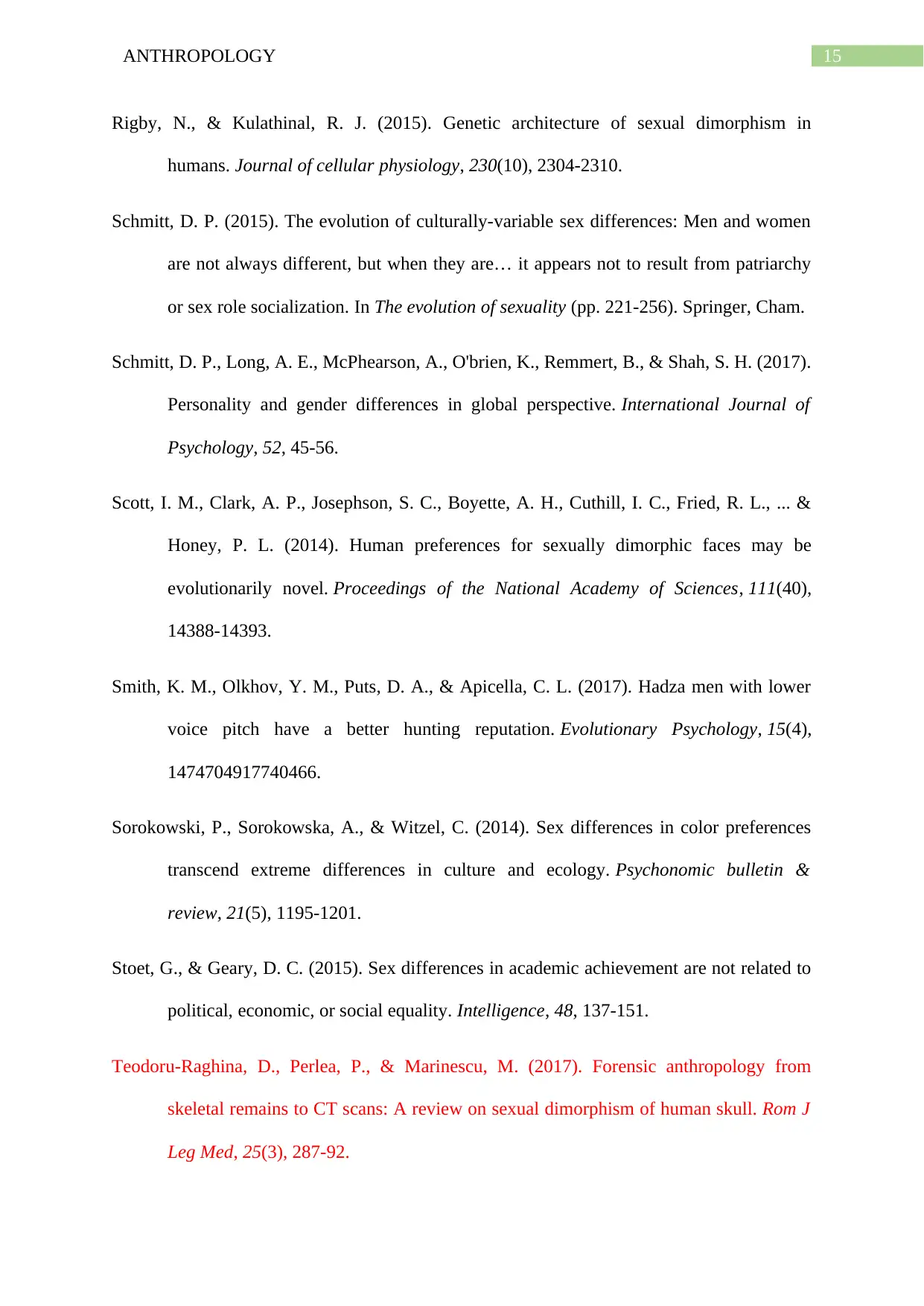
15ANTHROPOLOGY
Rigby, N., & Kulathinal, R. J. (2015). Genetic architecture of sexual dimorphism in
humans. Journal of cellular physiology, 230(10), 2304-2310.
Schmitt, D. P. (2015). The evolution of culturally-variable sex differences: Men and women
are not always different, but when they are… it appears not to result from patriarchy
or sex role socialization. In The evolution of sexuality (pp. 221-256). Springer, Cham.
Schmitt, D. P., Long, A. E., McPhearson, A., O'brien, K., Remmert, B., & Shah, S. H. (2017).
Personality and gender differences in global perspective. International Journal of
Psychology, 52, 45-56.
Scott, I. M., Clark, A. P., Josephson, S. C., Boyette, A. H., Cuthill, I. C., Fried, R. L., ... &
Honey, P. L. (2014). Human preferences for sexually dimorphic faces may be
evolutionarily novel. Proceedings of the National Academy of Sciences, 111(40),
14388-14393.
Smith, K. M., Olkhov, Y. M., Puts, D. A., & Apicella, C. L. (2017). Hadza men with lower
voice pitch have a better hunting reputation. Evolutionary Psychology, 15(4),
1474704917740466.
Sorokowski, P., Sorokowska, A., & Witzel, C. (2014). Sex differences in color preferences
transcend extreme differences in culture and ecology. Psychonomic bulletin &
review, 21(5), 1195-1201.
Stoet, G., & Geary, D. C. (2015). Sex differences in academic achievement are not related to
political, economic, or social equality. Intelligence, 48, 137-151.
Teodoru-Raghina, D., Perlea, P., & Marinescu, M. (2017). Forensic anthropology from
skeletal remains to CT scans: A review on sexual dimorphism of human skull. Rom J
Leg Med, 25(3), 287-92.
Rigby, N., & Kulathinal, R. J. (2015). Genetic architecture of sexual dimorphism in
humans. Journal of cellular physiology, 230(10), 2304-2310.
Schmitt, D. P. (2015). The evolution of culturally-variable sex differences: Men and women
are not always different, but when they are… it appears not to result from patriarchy
or sex role socialization. In The evolution of sexuality (pp. 221-256). Springer, Cham.
Schmitt, D. P., Long, A. E., McPhearson, A., O'brien, K., Remmert, B., & Shah, S. H. (2017).
Personality and gender differences in global perspective. International Journal of
Psychology, 52, 45-56.
Scott, I. M., Clark, A. P., Josephson, S. C., Boyette, A. H., Cuthill, I. C., Fried, R. L., ... &
Honey, P. L. (2014). Human preferences for sexually dimorphic faces may be
evolutionarily novel. Proceedings of the National Academy of Sciences, 111(40),
14388-14393.
Smith, K. M., Olkhov, Y. M., Puts, D. A., & Apicella, C. L. (2017). Hadza men with lower
voice pitch have a better hunting reputation. Evolutionary Psychology, 15(4),
1474704917740466.
Sorokowski, P., Sorokowska, A., & Witzel, C. (2014). Sex differences in color preferences
transcend extreme differences in culture and ecology. Psychonomic bulletin &
review, 21(5), 1195-1201.
Stoet, G., & Geary, D. C. (2015). Sex differences in academic achievement are not related to
political, economic, or social equality. Intelligence, 48, 137-151.
Teodoru-Raghina, D., Perlea, P., & Marinescu, M. (2017). Forensic anthropology from
skeletal remains to CT scans: A review on sexual dimorphism of human skull. Rom J
Leg Med, 25(3), 287-92.
Secure Best Marks with AI Grader
Need help grading? Try our AI Grader for instant feedback on your assignments.

16ANTHROPOLOGY
Torimitsu, S., Makino, Y., Saitoh, H., Sakuma, A., Ishii, N., Yajima, D., ... & Hashimoto, M.
(2016). Sex estimation based on scapula analysis in a Japanese population using
multidetector computed tomography. Forensic science international, 262, 285-e1.
Zentner, M., & Eagly, A. H. (2017). A sociocultural framework for understanding partner
preferences of women and men: Integration of concepts and evidence. In European
Review of Social Psychology: Volume 26(pp. 328-373). Routledge.
Torimitsu, S., Makino, Y., Saitoh, H., Sakuma, A., Ishii, N., Yajima, D., ... & Hashimoto, M.
(2016). Sex estimation based on scapula analysis in a Japanese population using
multidetector computed tomography. Forensic science international, 262, 285-e1.
Zentner, M., & Eagly, A. H. (2017). A sociocultural framework for understanding partner
preferences of women and men: Integration of concepts and evidence. In European
Review of Social Psychology: Volume 26(pp. 328-373). Routledge.
1 out of 17
Your All-in-One AI-Powered Toolkit for Academic Success.
+13062052269
info@desklib.com
Available 24*7 on WhatsApp / Email
![[object Object]](/_next/static/media/star-bottom.7253800d.svg)
Unlock your academic potential
© 2024 | Zucol Services PVT LTD | All rights reserved.
